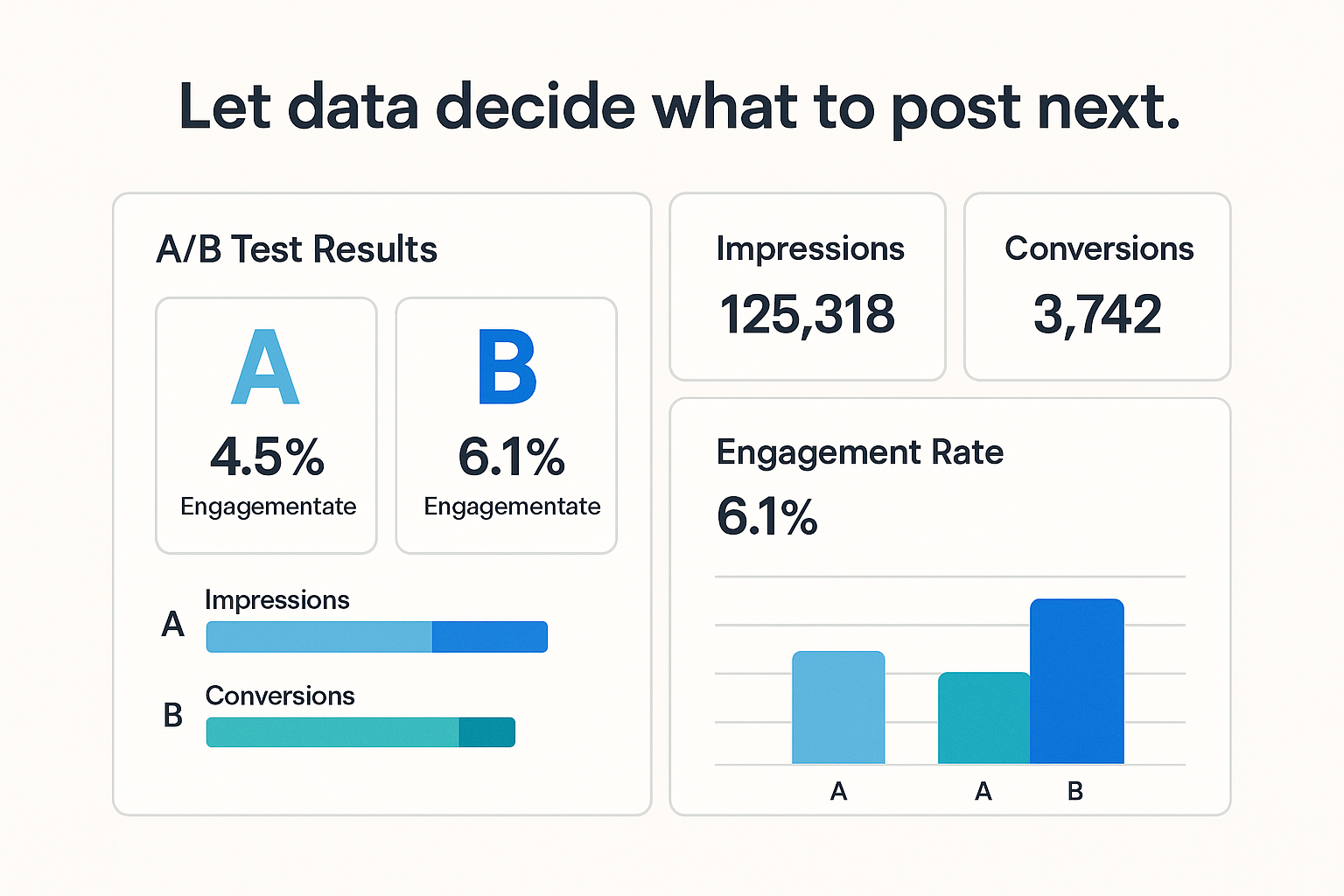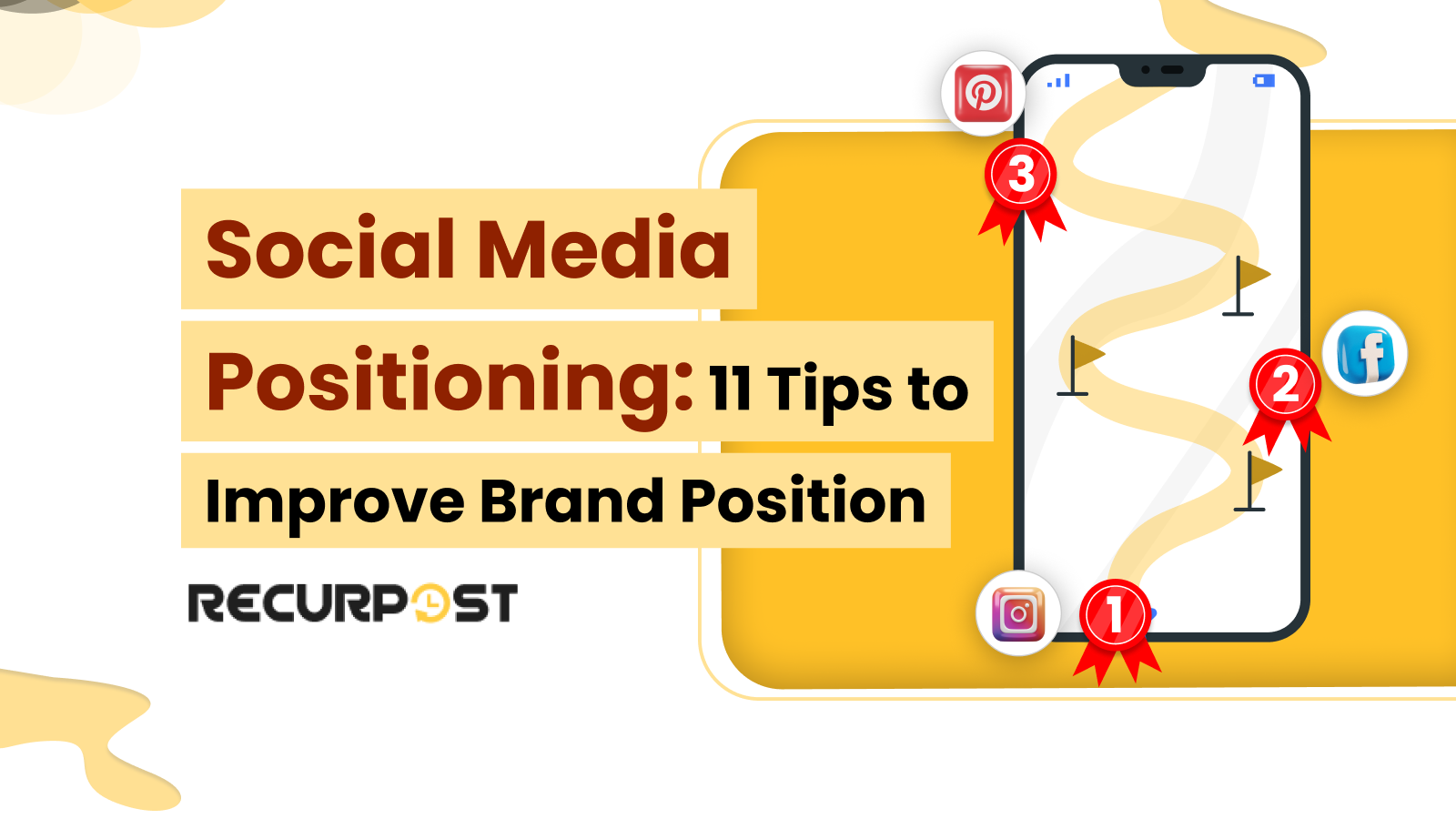Social Media Positioning transformed our brand from an industry footnote to a major player in one year.
We achieved that growth by refining brand positioning with deliberate content strategy and targeted social media marketing rather than complex algorithms or costly agencies. Our journey had bumps: inconsistent messaging and weak audience targeting left engagement metrics flat.
We built a systematic content planning process that put authentic connections above viral moments. This deliberate change in visual identity and brand messaging produced measurable results. The 11 positioning techniques below are not theory: they are exact tactics that tripled our brand presence and boosted conversion rates.
We focused on platform-specific content, audience segmentation, and a repeatable social media strategy to shape perception across social platforms. If you want to move beyond random posting and craft a positioning strategy that delivers, these proven tactics show exactly how we did it.
1. Understand Your Audience
The base of Social Media Positioning starts with knowing your target audience. We invested time in audience demographics and data analysis before shaping brand messaging or visual identity, making this step central to our social media strategy.

Audience demographics
Demographic analysis showed patterns that directed our content strategy. Millennials remain the most active on social media platforms, with 69.2% estimated to be using them in 2025. Gen Z females (16-24) spend nearly 3 hours daily, proving critical for platform positioning.
Each social platform attracts different audience segments. Facebook’s largest group is 25-34 (31.1%), while TikTok sees 35.3% in the same range. Gender gaps are clear: Pinterest remains 69.4% female, while LinkedIn leans 56.4% male (SproutSocial).
Education and income link strongly with platform-specific strategies. For example, college graduates are 54% more likely to use LinkedIn, compared to just 12% of high school users.
Audience behavior patterns
Behavior analysis revealed engagement opportunities beyond demographics. Facebook users connect mainly with friends and family, while Instagram users engage with visual storytelling and social media content.
Time spent differs widely: YouTube users average 49 minutes daily, compared to 32 on Facebook. These insights shaped our content calendar, posting schedule, and format planning.
The behavior study also exposed engagement trends. Around 61% of Instagram users discover products there, so it has become a vital channel for brand positioning on social platforms. Similarly, 35% of X users interact with brand content daily, proving a strong engagement metric.
Audience pain points
The most valuable step was spotting audience pain points – the problems they need solved. Customer issues usually fall into four categories:
- Financial pain points: Budget concerns and price sensitivity
- Productivity pain points: Need for time-saving solutions
- Process pain points: Demand for simplified workflows
- Support pain points: Need for reliable assistance
By spotting these through surveys, conversations, and social listening, we tailored our media marketing strategy to position our brand as the answer. For example, when we saw content creation issues as a major pain point, we produced templates and guides that directly solved it.
2. Define Your Unique Value Proposition (UVP)
After learning about our target audience, crafting a clear, unique value proposition (UVP) became central to our Social Media Positioning strategy. A UVP communicates why customers should pick your brand identity over competitors, a written promise of what your business delivers.

UVP Benefits
Our UVP boosted growth through three main benefits in digital brand strategy.
First, it created relevancy by showing how our products solved audience pain points and delivered brand differentiation.
Second, it delivered measured value through clear benefits customers could expect, aligning with content strategy and brand messaging.
Third, it gave clarity that made our offer understandable in about 5 seconds, crucial in fast-scrolling social platforms and media marketing feeds.
In practice, this meant turning vague messaging into targeted content that resonated with audience demographics. Our engagement metrics rose as followers recognized the clear value we gave them.
UVP Differentiation
With only 5% of brands considered unique by consumers as of January 2024 (Forbes), brand differentiation was vital to stand out. We showcased our perspective by finding gaps in competitor positioning strategies. This step became vital in a crowded marketplace where brand positioning drives consumer choice.
We solved clear problems instead of only pushing products. By running competitor analysis, we found unaddressed audience pain points and positioned our brand as the solution. This built strong competitive differentiation in our social media presence.
UVP Communication
Effective UVP communication across social media platforms requires consistent practice. We ensured bios, captions, and pinned posts clearly showed our unique value proposition (UVP). We applied the 80/20 rule: 80% content creation for education, trends, and engagement; 20% for promotion.
The language we used mattered. We avoided jargon and exaggeration. Instead, we created brand messaging in our audience’s language, joining real conversations. This authenticity built trust and reinforced brand positioning on social platforms as a valuable resource instead of another advertiser.
3. Craft Consistent Brand Messaging
Consistent messaging formed the base of our Social Media Positioning strategy. Keeping cohesion across social media platforms created an instantly recognizable presence, reinforcing brand identity with every interaction.

Brand Messaging tone
We built a clear brand voice for authentic communication and stronger social media branding.
First, we defined brand personality traits: straightforward, pragmatic, clever, and helpful. This framework guided messaging, ensuring the target audience received consistent communication across each social platform.
In practice, we created brand messaging guidelines showing tone variations for different cases. For example, we documented responses for compliments versus complaints while keeping the same brand voice.
We also built practical examples of dos and don’ts to guide anyone managing social media brand positioning. This tone consistency built trust and strengthened brand recognition across time.
Brand Messaging visuals
Visual brand elements play a critical role in brand recognition. Consistency in color palette, logo usage, and visuals can raise recognition by 80%. We used identical profile photos and cover images across platforms and applied branded colors consistently to strengthen visual identity.
Our visual identity guidelines set exact color codes, typography rules, and logo placement. This careful consistency built a recognizable presence that audiences spotted instantly, even without seeing our name.
Brand Messaging storytelling
Storytelling shaped the emotional side of our positioning strategy. A cohesive brand story connected all social media channels, helping our audience form deeper ties with our content. We made sure storytelling:
- Reflected audience pain points and values
- Kept consistent themes and messaging
- Collaborated with followers to co-create brand essence
- Connected emotions with clear brand benefits
As a result, followers anticipated and engaged with our content at higher rates. With consistent brand messaging, visual aesthetics, and storytelling, we built a social media presence that was recognizable, trusted, and engaging.
4. Leverage Platform-Specific Strategies
Each social media platform offers distinct chances for brand positioning that require tailored platform-specific strategies. Our success came from shaping content strategy around platform strengths, target audience expectations, and technical needs.

Strategies for Instagram
On Instagram, visual aesthetics drive engagement. We prioritized high-quality images and applied a consistent visual identity across the feed. Carousels worked well, boosting engagement metrics. For best results, we kept 4:5 ratios for posts and 9:16 for stories and reels.
Hashtag strategy expanded reach. We built a mix of popular and niche tags, tailoring them to grow discoverability within target audience segments.
We repurposed social media content into Stories, putting our brand in front of followers’ queues. Nearly 50% of Instagram users visit websites after Story exposure, boosting conversion metrics.
Strategies for LinkedIn
On LinkedIn, we used a professional tone for its business-driven audience demographics. Multi-image posts earned more clicks, while thought leadership articles built authority and brand messaging.
LinkedIn users also value authentic content showing brand personality and company culture. We balanced insights with team glimpses. This social media strategy tapped into LinkedIn’s lead generation strength, delivering 97% of business social media leads.
Strategies for TikTok
TikTok’s discovery-first algorithm reshaped our content creation. Unlike other social platforms, TikTok emphasizes discovery, giving brands chances to reach new audiences.
We kept videos 21-34 seconds, focusing on creative content aligned with trends. This grew brand awareness as users found our content organically. TikTok drives buying power: 71.2% of users purchase after discovering products in their feed, boosting social media ROI.
5. Engage with Your Community
Building meaningful community engagement fueled our growth. Community management connects brands with followers and builds trust. 88% of managers confirm branded communities boost overall business strategy and outcomes.

Engaging through comments
Comments hold valuable opinions. Our social media strategy prioritized two-way communication through prompt replies to audience interactions. This showed real interest in feedback while strengthening relationships at scale.
Personalization improved engagement metrics, replacing generic responses with thoughtful replies that addressed exact points. This humanized our brand identity, making customers feel they interacted with real people, not a faceless company.
Even negative feedback became an opportunity. As one manager said, “We stay responsive, even with criticism”. This balanced community engagement reinforced our Social Media Positioning strategy.
Engaging using UGC
User-generated content (UGC) became central to our social media positioning strategy, with 86% of consumers more likely to trust brands that share UGC. We applied several approaches:
- Launching contests and challenges, encouraging users to post content
- Tracking tagged photos through social listening tools
- Sharing testimonials to boost online reputation management
Recognition proved valuable, showing UGC mattered. This created a collaborative narrative around our brand messaging and built stronger ties with our audience demographics.
Engaging via live sessions
Live streaming created direct connections, with 80% of users preferring video to other formats. We used interactive polls, live chat, and direct interaction during broadcasts.
Afterwards, we messaged Instagram Live participants and replied to missed comments, improving ongoing community engagement. Cross-promotion across social media platforms grew reach, while pre-event marketing and post-event content extended value.
6. Implement Data-Driven Content Strategies
Data-driven choices fueled our Social Media Positioning success. We consistently relied on measurable performance metrics instead of assumptions to guide our media marketing strategy.

Analytics
Social analytics gave our team valuable insights. Social media audits and intelligence became vital inputs for predicting audience behavior and measuring campaign success. Today, 60% of brands quantify engagement metrics in terms of revenue, while 57% track conversion metrics tied to social efforts.
Before content creation, we used AI-powered social listening tools to confirm if trends resonated with broad audiences. This revealed conversation themes worth adding. At the same time, we used Post Performance Reports to review individual posts, giving a unified view across social platforms and showing which messages worked best.
A/B testing
A/B testing was vital for refining our positioning strategy. This structured method tested small content variations with different audience segments, then compared results to find the most effective version.
In practice, we tested call-to-action phrases, image types (photos vs. infographics), video length, and hashtag placement. Even minor changes produced stronger engagement metrics.
The process followed a framework: choose one element, create two variations, test on audience segments, measure results, then apply the winning option.
Optimization
Ongoing refinement became standard. We tracked key performance indicators (KPIs) such as engagement rate, click-through rate, and conversion rate to spot improvement areas. When Figo Pet Insurance invested in video, they used real-time analytics to refine content and decide which videos to amplify with budget, leading to audience growth and revenue-driving ads.
Ultimately, this data-driven content strategy allowed us to invest resources wisely. By automating analytics and measurement and using AI to surface social data faster, we saved time and made informed choices that fueled our brand’s growth.
7. Collaborate with Influencers and Thought Leaders
Influencer partnerships amplified our Social Media Positioning efforts, driving brand advocacy beyond standard content. Over 80% of marketers now consider influencers essential in any social media strategy.

How to Select Influencers
Picking the right influencers was critical for social media positioning success. We first studied audience demographics to align with our target audience. Then, we calculated engagement metrics, aiming for at least 3% as proof of authentic interaction.
Beyond metrics, we reviewed content quality and alignment with brand values. The most authentic influencers often came from existing brand ambassadors who already loved our products. This natural match made partnerships genuine instead of transactional.
ROI tracking of Influencers
Measuring influencer ROI meant going beyond immediate sales. While businesses earn $5.78 per $1 spent on influencer marketing, our approach tracked multiple performance metrics:
- Conversion metrics: Unique URLs and promo codes to link sales to influencers
- Engagement metrics: Comments, shares, and saves showing audience response
- Brand sentiment: Surveys tracking awareness and consideration
Authenticity of Influencers
Authenticity drove our influencer strategy. We gave creative freedom so influencers could share real experiences in their own brand voice. Clear disclosure of sponsored posts built trust with audiences while maintaining online brand credibility for both sides.
We prioritized long-term partnerships over one-off deals. This created deeper brand advocacy as influencers became true fans. Many even exceeded deliverables, giving extra mentions and replying quickly, clear signs of authentic collaboration.
8. Utilize Visual Storytelling
Visual content powered our Social Media Positioning strategy, with storytelling elements driving audience growth and stronger engagement metrics.

Visual Storytelling with video
Video content strengthened our brand presence across social platforms. Research shows 89% of consumers purchase after videos, making this format critical for conversion metrics and sales campaigns.
First, we used short-form videos (under 60 seconds) that delivered concise, memorable messages while boosting brand awareness.
Second, we produced behind-the-scenes clips that humanized our brand identity and built authentic audience connections.
Third, we ran live streams, creating real-time community engagement and gathering immediate audience feedback.
For best results, we kept videos 21–34 seconds and built visual storytelling arcs with a clear protagonist (matching target demographic), conflict (audience pain points), and resolution (brand solution).
Visual Storytelling with Infographics
Infographics changed how we shared complex ideas. By blending text, visuals, and design, we delivered clear content positioning. Content with infographics raised web traffic 12%, making them vital for audience expansion.
We prioritized simplicity in design, starting with core data and adding supporting layers as needed. This minimalist style avoided overload and kept audience’s attention. For impact, we applied contrasting colors to key elements and simple typography to aid readability.
Visual Storytelling with brand aesthetics
Consistent visual aesthetics drove recognition and engagement across social media platforms. Beyond design, we built a cohesive visual identity reflecting our brand personality and values.
We created a brand aesthetics guide defining color palette, typography, and imagery style. We shifted from stock photos to original content tailored for our audience demographics. This boosted recognition as followers instantly spotted our branded content while scrolling feeds.
9. Automate Social Media Posting
Automation streamlined our social media strategy, structuring Social Media Positioning while saving hours of manual work. Our brand’s growth came from methodical content scheduling that kept consistent brand messaging without losing authenticity.
Social Media Posting tool – RecurPost
RecurPost became central in our automation tools, mainly serving as our social media scheduling platform. We use it for its easy interface and its ability to post consistently across social media platforms.
The dashboard provides practical scheduling features: an AI caption writer for content creation, a content calendar for visualizing the posting schedule, and bulk uploads for up to 250 posts per CSV or 2000 total.
One strong feature is evergreen content recycling, letting us repurpose top-performing posts without manual work. The platform also adds AI scheduling for best times, category-based media strategy templates for content organization, team collaboration, and white-label analytics and measurement.
It integrates with all major social media platforms. For users wanting a steady social media presence, it’s a practical automation tool for managing content distribution.
Social Media Posting Best Practices
First, we balanced automation and human interaction. Automated posting handled evergreen content, while we manually responded to time-sensitive topics and audience interactions. Second, we scheduled posts for the best engagement metrics, usually during lunch and after work when the target audience was active.
The most effective practice was avoiding over-posting. We limited posts to 2–3 daily across social platforms to prevent fatigue. We also monitored scheduled social media content to keep it relevant, rarely scheduling more than a month ahead.
10. Monitor and Analyze Competitor Strategies
Competitive intelligence fueled our Social Media Positioning success by showing market gaps and opportunities. Structured competitor analysis gave insights that shaped our media strategy and supported faster growth.

Competitor Strategies tools
Specialized automation tools simplified competitor tracking. Sprout Social was our main platform for monitoring rival performance across channels like Facebook, Twitter, and Instagram. With AI-powered insights, we spotted patterns in competitor content and audience engagement metrics.
Competitor Strategies gaps
Studying competitors showed unserved audience needs. We found untapped social media platforms where rivals had low presence, creating opportunities to engage target demographics they ignored.
We also uncovered content format gaps. When rivals lacked videos or polls, we added these to break saturation. Performance metrics showed which content types attracted competitor audiences, guiding our own content strategy.
Competitor Strategies differentiation
In the end, competitor analysis helped us position our brand identity above the rest by spotting industry trends and finding ways to deliver superior value. Instead of copying, we tastefully compared our products with competitor solutions in social media content.
For example, we showcased our unique value proposition (UVP) aligned with audience pain points, similar to SodaStream promoting environmental benefits on Facebook to differentiate from bottled soda. This competitive differentiation helped us capitalize on competitor weaknesses while strengthening our own brand positioning.
11. Measure, Analyze, and Continuously Improve
Ongoing measurement fueled our growth by refining Social Media Positioning through data-driven choices. Tracking and adapting based on performance metrics helped us triple brand presence within one year.

Measure with KPIs
The right Key Performance Indicators (KPIs) gave direction for our social media strategy. Beyond vanity metrics, we tracked metrics tied to business goals:
- Reach metrics: Followers, impressions, traffic, share of voice
- Engagement metrics: Clicks, likes, shares, comments, mentions
- Conversion metrics: Sales revenue, lead conversions
- Customer loyalty: Cost per lead, lifetime value
Social Media Audits
Quarterly audits supported our positioning. Each audit reviewed our presence across social media platforms, analyzing current engagement metrics and spotting new opportunities.
We also gathered profile data, tracked top-performing social media content, reviewed audience demographics, and ranked which platforms delivered the strongest results. This process, taking 2–4 days with automation tools, gave a clear snapshot of brand positioning effectiveness.
Improve agility
Agile principles boosted our ability to adapt to market shifts. Small pods of fewer than 10 worked on specific audience segments. These pods held quarterly sessions to test ideas for refining media strategy, audience targeting, and creative execution.
We then reviewed both hard performance metrics, like ROI, and soft ones, such as team engagement. Companies applying this agile model gained faster speed to market, stronger ROI, and improved team satisfaction compared to traditional methods.
Case Studies: Social Media Positioning Examples That Worked
Some brands have mastered Social Media Positioning strategy so well that their names are synonymous with their industries. They don’t just sell products; they sell a lifestyle, a mission, or a brand identity.
1. Apple: Mastery in Storytelling and Minimalist Branding

Apple has long led in branding, and its social media branding approach is no exception. Instead of pushing promotions, Apple leans on user-generated content (UGC) with campaigns like #ShotOniPhone. This method turns everyday users into brand ambassadors, reinforcing Apple’s innovative image and strong brand positioning.
- Apple rarely posts traditional advertisements on social media, focusing instead on sleek visuals and concise, compelling messaging.
- Its content aligns perfectly with its minimalist brand identity, clean, bold, and always on-brand.
- By leveraging UGC, Apple shifts the focus from product features to user experience, making the brand feel aspirational yet accessible.
2. Nike: Powerful Social Justice Messaging

Nike shows how a brand blends social issues with marketing strategy. From “Just Do It” campaigns to bold stances on equality, Nike positions itself as more than apparel; it’s a movement.
- The brand consistently delivers high-quality, emotionally charged video content that resonates with its audience.
- It engages in cultural conversations without being performative, demonstrating authenticity through long-term commitments to social causes.
- Nike has a thorough social marketing plan, and it also collaborates with athletes and influencers who embody its brand core values, further strengthening its credibility.
3. Tesla: Innovation-Focused Branding

Tesla’s social media presence reflects futuristic, disruptive social media brand positioning. Unlike traditional auto brands that rely on ads, Tesla takes a tech-first digital brand strategy.
- Its CEO, Elon Musk, is one of the most active business leaders on Twitter, using his personal brand to fuel Tesla’s visibility.
- Tesla’s social media strategy focuses heavily on innovation, sharing updates on new technology, self-driving advancements, and sustainability efforts.
- The company generates massive engagement without a traditional marketing budget, proving that strong brand positioning can replace expensive ad campaigns.
Conclusion
Building strong brand visibility on social media platforms is a marathon, not a sprint. These 11 steps, from audience insights to tools, create a cohesive, recognizable social media presence.
For example, use a Social Media Analysis Template to track engagement metrics, or download an Instagram Content Calendar Template to plan posts. Tools like RecurPost simplify content scheduling and analytics so you can focus on creativity.
Active engagement, consistent brand messaging, and data-driven planning strengthen Social Media Positioning. With persistence and the right social media strategy, your business can stand out across multiple social platforms. Ready to boost your brand positioning? Apply these tips today and watch your digital presence strategy grow!
FAQs on Social Media Positioning
1. What is the difference between brand positioning and social media positioning?
Brand positioning is how you want your overall brand to be seen in the market, helping your brand remain relevant over time. Social media positioning refers specifically to how your brand is presented and perceived in the social media world. You use social media positioning to enhance brand visibility on different platforms while supporting your broader brand goals.
2. How often should I review my social media strategy?
You should review your social media strategy at least once every quarter to stay current in the fast-moving social media world. If you see shifts in engagement or run paid campaigns, check more often to make sure your approach helps your brand remain relevant and continues to enhance brand visibility.
3. What tools can help improve social media presence?
Use scheduling platforms, analytics trackers, and content creation tools to boost presence. For example, RecurPost manages content scheduling, while analytics reveal top social media content to improve social media presence.
4. How do I measure ROI from social media positioning?
Social Media Positioning tracks how you show up and engage online. Measure ROI by monitoring engagement metrics, traffic, and conversion metrics from social media platforms. Use analytics to see how efforts boost brand visibility and sales.
5. What’s the best platform for B2B social media positioning?
LinkedIn is the strongest B2B platform social media positioning tool. It connects you with professionals, lets you share insights, and builds trust, keeping your brand social media positioning relevant and boosting visibility where it matters.

Shalini Nagar is an experienced content writer with a proven track record of creating diverse and engaging content across various formats. With years of expertise in crafting blogs, articles, she excels at delivering compelling narratives tailored to different audiences.





